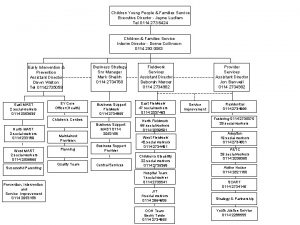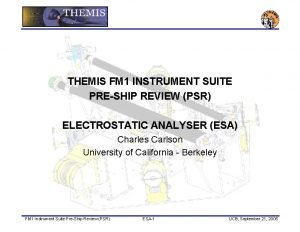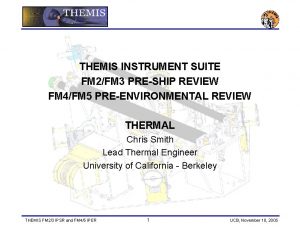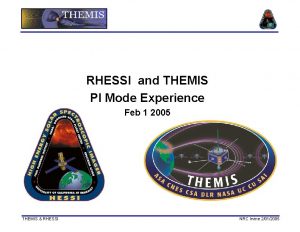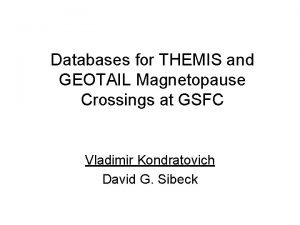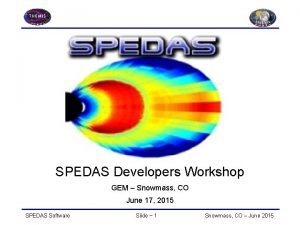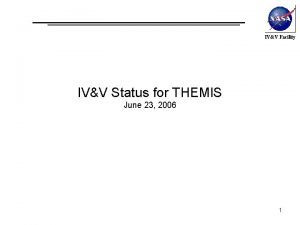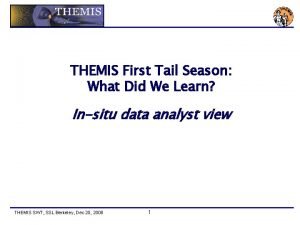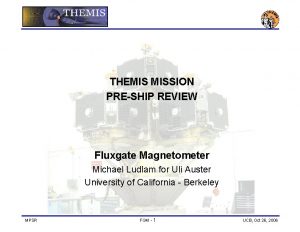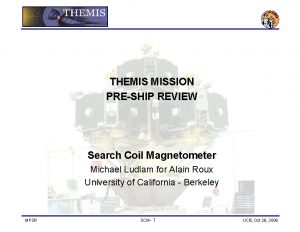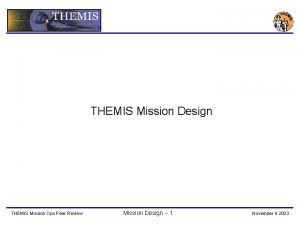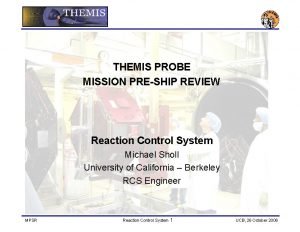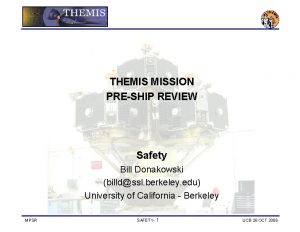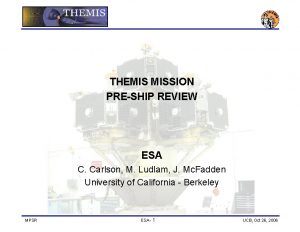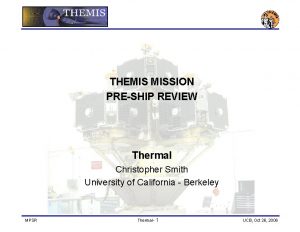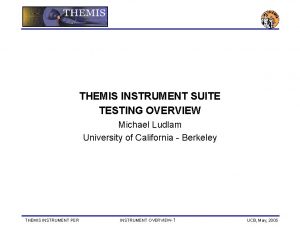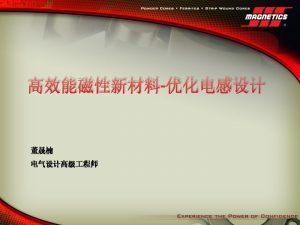THEMIS MISSION PRESHIP REVIEW DC MAGNETICS Michael Ludlam











- Slides: 11

THEMIS MISSION PRE-SHIP REVIEW DC MAGNETICS Michael Ludlam University of California - Berkeley MPSR DC MAGNETICS- 1 UCB, Oct 26, 2006

Overview • 5 n. T requirement • Predicted field at FGM sensor • 0. 1 n. T stability requirement • Success of deperming • Future care of probes before launch MPSR DC MAGNETICS- 2 UCB, Oct 26, 2006

Requirements There are two DC Magnetics requirements: 1. M 31 a – At the position of the magnetometer the total field from the spacecraft is less than 5 n. T. 2. M 31 b – The stability of the spacecraft field over 12 hours shall be less than 0. 1 n. T 3. Both of the requirements are met. MPSR DC MAGNETICS- 3 UCB, Oct 26, 2006

5 n. T Requirement • Data taken with probe inside coil system used to null the earth magnetic field. • Spacecraft is rotated in two planes; x-y and x-z. • Two magnetometers used to measure spacecraft field inside the nulling coils – one at 1. 5 m the other at 2. 5 m from the center of coordinate system. • FGM instrument sensor on deployed boom is close to the 2. 5 m sensor when the probe is rotated by 45º. MPSR DC MAGNETICS- 4 UCB, Oct 26, 2006

5 n. T Requirement Dipole and quadrupole moments are calculated from the data taken. Using these moments it is possible to calculate the field at any distance around the probe. Comparing the calculated field to the measured data: Probe Field Strength at 45 deg. Measured (n. T) Field Strength at 45 deg. Calculated from Quadrupole (n. T) Difference (n. T) F 1 1. 55 1. 58 0. 03 F 2 0. 8 1. 17 0. 37 F 3 0. 86 1. 29 0. 43 F 4 1. 27 1. 34 0. 07 F 5 0. 58 1. 31 0. 73 45 degrees is the approximate location of the FGM sensor. MPSR DC MAGNETICS- 5 UCB, Oct 26, 2006

F 1 Results Dipole moment (Gauss*cm^3) Mx -27. 636 My Mz 111. 965 15. 983 Quadrupole moment (n. T*m^4) Qx_ Qy_ Qz_ Q_x 13. 876 4. 89 -5. 624 Q_y 4. 89 -11. 406 -9. 191 Q_z -5. 624 -9. 191 -2. 47 MPSR DC MAGNETICS- 6 UCB, Oct 26, 2006

Field at FGM Sensor MPSR DC MAGNETICS- 7 UCB, Oct 26, 2006

Field at FGM Sensor Probe Number Bx (n. T) By (n. T) Bz (n. T) Brms (n. T) Probe 1 1. 18 0. 21 0. 40 1. 26 Probe 2 0. 50 0. 32 0. 14 0. 61 Probe 3 0. 34 0. 02 0. 10 0. 36 Probe 4 0. 80 0. 95 0. 57 1. 36 Probe 5 0. 08 -0. 22 -0. 14 0. 28 Requirement M 31 a – At the position of the magnetometer the total field from the spacecraft is less than 5 n. T. Pass MPSR DC MAGNETICS- 8 UCB, Oct 26, 2006

0. 1 n. T Requirement 2. The stability of the spacecraft field over 12 hours shall be less than 0. 1 n. T: Pass This was verified at the first F 2 tests in March & April 2006 at JPL. The results of this were presented at the pre-environmental review in June. Variance of the field from having the spacecraft powered or induced by field changes is within the 0. 1 n. T requirement. MPSR DC MAGNETICS- 9 UCB, Oct 26, 2006

Deperming • Deperming of probes was successful with all probes deperming well – an improvement of a few n. T at 1 m. • During deperming of F 1 probe the rotation had to be stopped at 12 Gauss. [Earth’s field is approx. 0. 5 Gauss]. This resulted in perming the probe to a field of 80 n. T at 1 m. This would be a field of about 5 n. T at the FGM sensor. The probe was depermed successfully and the field was reduced to about 6 n. T at 1 m. The perming of the probe showed that although it permed up it did not perm to unacceptable levels and depermed easily. MPSR DC MAGNETICS- 10 UCB, Oct 26, 2006

Future care of probes before launch • Magnetic cleanliness effort only finishes at launch. • Now that DC Magnetics tests have been run there is no way of knowing if the probes are magnetized between now and flight. • Probes need to be protected from high magnetic fields that may cause them to perm up. A magnetic cleanliness plan has been agreed with Boeing. All areas where the probes will be stored have been surveyed. Tools also will be screened. • Magnetic witness plates will be used to verify the probes are not subjected to large fields during shipment. MPSR DC MAGNETICS- 11 UCB, Oct 26, 2006

